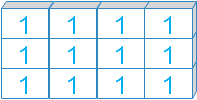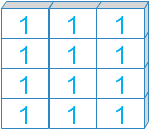Numpy ones()
numpy.ones(shape, dtype=None, order='C')shape | Int, or sequence ( 2,3) , the shape of the output |
dtype | data-type( Optional ), Data Type of returned array. |
order | {'C','F'} Optional, how the output is to be stored. C- style or Fortan style |
 |  |
| Shape: (3, 4) Dimension 2 | Shape: (4, 3) Dimension 2 |
Using shape
Read more on shapeimport numpy as np
my=np.ones(4)
print(my)[1. 1. 1. 1.]my=np.ones((4,2))[[1. 1.]
[1. 1.]
[1. 1.]
[1. 1.]]dtype
We will try to return string dtypeimport numpy as np
my=np.ones(4,dtype=str)
print(my)['1' '1' '1' '1']my=np.ones(4,dtype=float)[1. 1. 1. 1.]my=np.ones(4,dtype=int)[1 1 1 1]
Subhendu Mohapatra
Author
🎥 Join me live on YouTubePassionate about coding and teaching, I publish practical tutorials on PHP, Python, JavaScript, SQL, and web development. My goal is to make learning simple, engaging, and project‑oriented with real examples and source code.
Subscribe to our YouTube Channel here
This article is written by plus2net.com team.
https://www.plus2net.com

 Python Video Tutorials
Python Video Tutorials